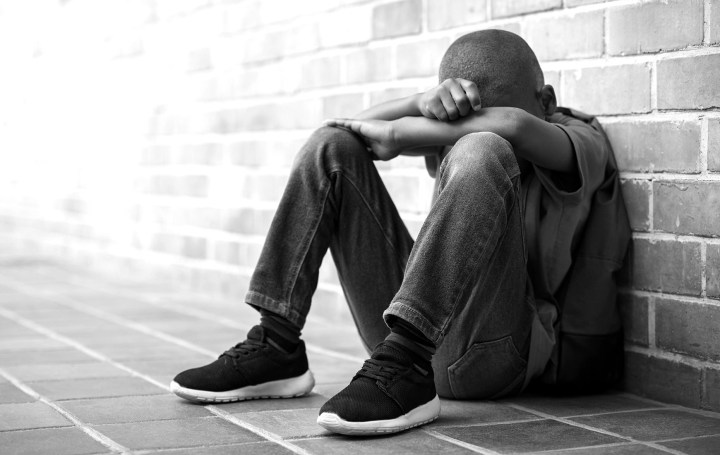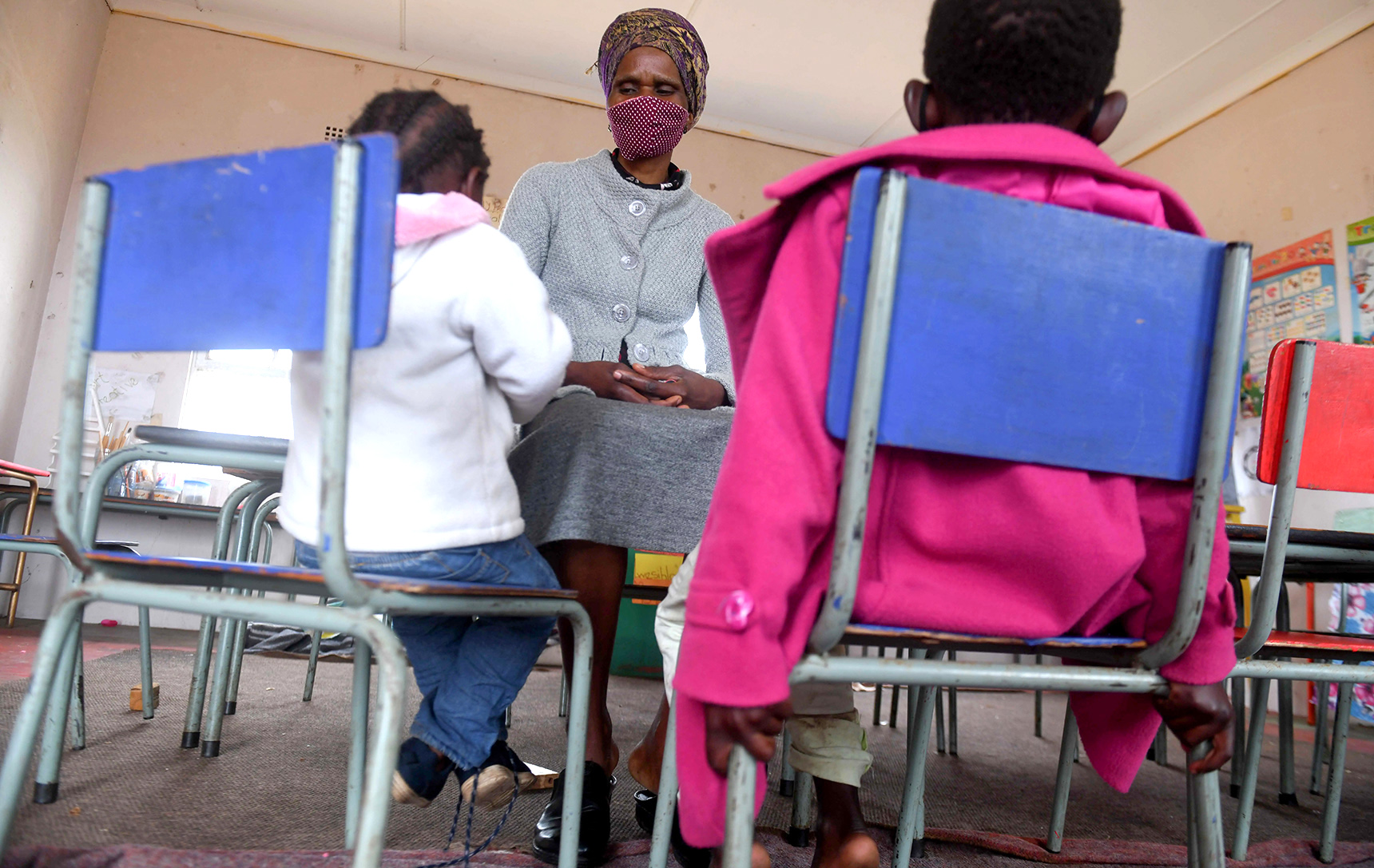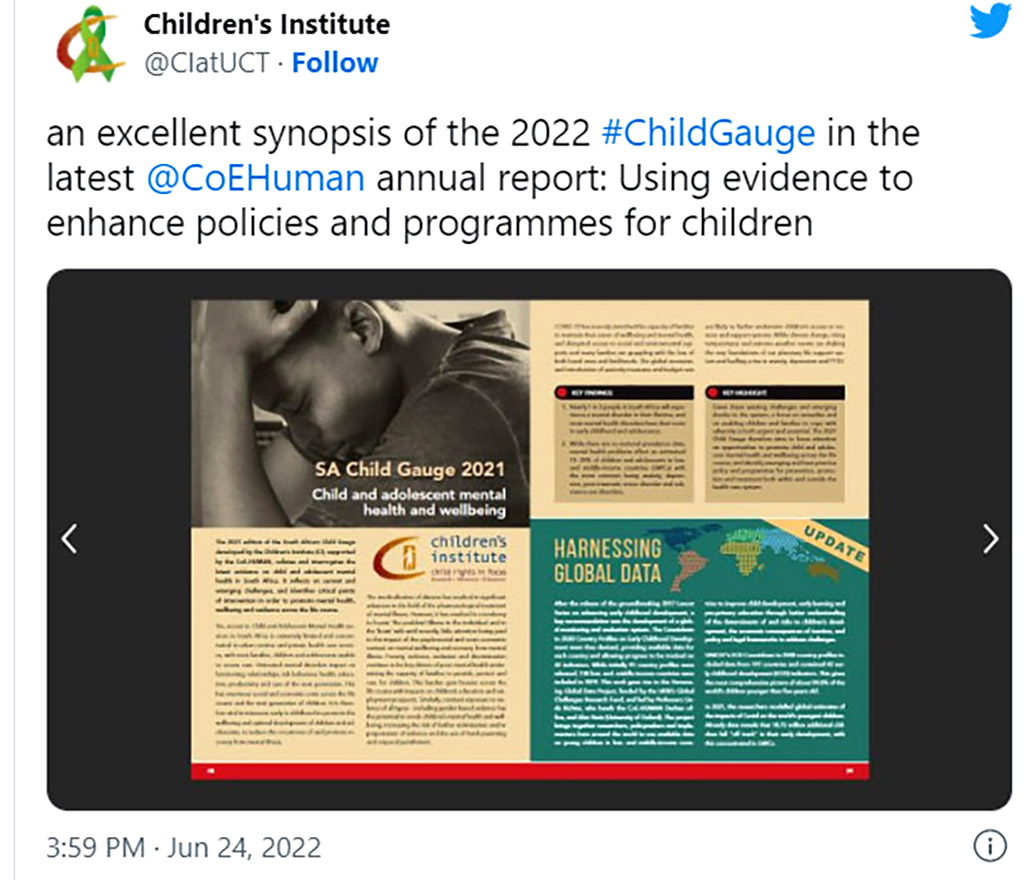SPOTLIGHT
Child and adolescent mental health services are in crisis, says report – this is what the Health Department aims to do about it

The latest South African Child Gauge focuses on child and adolescent mental health and highlights the importance of early interventions for good mental health outcomes. Tiyese Jeranji looked at the report’s findings and recommendations and asked the Health Department how it will tackle the issues highlighted.
Plans are under way for a study to determine the ability of South Africa’s public mental health system to cater for the needs of children and adolescents with mental health problems. Health Department spokesperson Foster Mohale told Spotlight the findings and recommendations will contribute towards improved mental health services for them.
He could not provide many details because the study will be commissioned later this financial year.
Foster was responding to Spotlight’s request for input on the South African Child Gauge released recently by the Children’s Institute at the University of Cape Town (UCT). This report, however, already highlights the needs of children with mental health conditions and makes important recommendations on how the public health system can respond to meet those needs. The gauge is an annual review of the situation of children in the country.
What the gauge found: The numbers
The latest edition of the gauge focuses on child and adolescent mental health and how early experiences of adversity can affect people throughout their lives, often with great costs to the individual and society.

Realistic baby dolls and teddy bears are among the props used to help children who are victims of rape and sexual abuse feel more at ease expressing their injury and trauma. (Photo: Ufrieda Ho / Spotlight)
The report cites statistics showing that “even with the best possible mental health promotion and prevention strategies, approximately 10% to 20% of children and adolescents will develop a mental disorder and/or a neurodevelopmental disability”. In South Africa, however, only one in 10 children diagnosed with a mental condition that is treatable will have access to care. This has a ripple effect where children, in the absence of support and necessary care, struggle at school and eventually drop out, with serious implications for their economic prospects. Statistics from Unicef South Africa’s U-Report also show that “65% of young people with mental health issues did not seek help”, so many children and adolescents fall through the cracks.
Read in Daily Maverick: “Child and adolescent mental health services in SA… let us not be found wanting (again)”
Other statistics highlighted in the report show that “two-thirds of children in the country live in poverty and nearly one in two children have experienced violence, including physical violence and sexual abuse”.
Professor Shanaaz Matthews, director of the Children’s Institute, said in a statement: “These children and adolescents are at particular risk of poorer mental health, which can perpetuate an intergenerational cycle of poverty, violence and ill-health. Given the scale and intergenerational nature of violence against children, our response to trauma needs to extend beyond dedicated psychological and psychiatric services.”
Professor Mark Tomlinson, co-director at the Institute for Life Course Health Research in the Department of Global Health at Stellenbosch University, told Spotlight that part of what they wanted to do with the gauge was to provide a broader view of what’s needed to create conditions where children and adolescents can thrive.
Tomlinson said many services in the government that are key for mental health would never be seen as mental health interventions – such as having non-judgemental, caring health services for adolescent girls seeking abortions. “That is not seen as a mental health intervention but it’s a massive mental health intervention because if she doesn’t get that, her risk of developing a mental health disorder is massive,” he says.
Expanding access: Services in schools
Tomlinson said part of creating conditions for children to flourish is having better services. “The Western Cape has quite a number of really good inpatient units, Gauteng as well. But in Mpumalanga, Limpopo and other provinces there is next to nothing. The services when something goes very wrong are really key.

In South Africa, only one in 10 children diagnosed with a mental condition that is treatable will have access to care. (Photo: Black Star / Spotlight)
“But we are also trying to make a case that’s broader than that and more complex. We really need to see mental health like a continuum where, only on one end, you need the services and along that continuum, you need different things,” he said, adding that schools also need to be equipped to deal with issues.
Families and schools are very good platforms to nurture good mental health, Tomlinson said. This didn’t mean teachers must be psychologists, only that schools were a great setting to “create a good environment for mental health”.
It would help if teachers created an environment in which it was easy for pupils to talk to them and they talked openly to pupils. “This is not extra work at all. In turn, when the environment is conducive, it even becomes easy to teach.”
Read in Daily Maverick: “Children’s mental health and the digital world: how to get the balance right”
Mohale said the Health Department has put a number of interventions in place and plans to increase access to and improve the quality of mental health services, including early identification, treatment and rehabilitation to “tackle the effects, as well as to make the services available for children and adolescents”.
These interventions included integrated school mental health services and integrated community health worker services. “Screening and referral of learners for mental health programmes are integrated into the school health policy and programme to ensure early identification, care, treatment and rehabilitation, including referral of learners with mental health problems.”
Sharon Kleintjes, a professor of intellectual disability in the Department of Psychiatry and Mental Health at UCT, acknowledged that there are already a number of valuable policies and programmes in place to promote mental health, including a “focus on life skills in the school curriculum, a national school safety framework to prevent violence, care and support for teaching and learning, and school health services”.
“Implementation and coordination, however, remain a challenge,” she said, “and greater efforts are needed to improve the physical and psychological health of the school, and to strengthen links to health services and other community resources.”
Mohale conceded that although there has been progress on the now lapsed Mental Health Policy Framework, a lot still needs to be done. “Not all that was intended by the [framework] was achieved, especially at implementation level. Provinces cited a shortage of resources, both human and financial, for non-achievement of some objectives.”
Expanding access: Health services
The gauge stresses that “child and adolescent mental health services are in crisis”. Reflecting on resources for mental health services for young people, it says there are only a few child and adolescent psychiatrists and mental health professionals and most of them work in urban centres and the private sector.
In a recent answer to a written parliamentary question, Health Minister Joe Phaahla said it “is estimated that 6,566,703 persons need care for common mental disorders and 1,292,991 of those aged 15 years and older need care for severe psychiatric conditions”. In a province like the Eastern Cape, there were only two filled psychiatry posts in the public sector, giving a ratio of one psychiatrist to more than three million people in the public sector.
He did not provide a breakdown of children’s mental health services.
An important plea in the gauge is to move from “describing the problem to thinking [about] how to strengthen services and systems for children and adolescents”, including developing a long-term vision for these services.
Its recommendations include creating multidisciplinary teams in districts to promote mental health literacy and, in turn, care-seeking behaviour in this age group. Ideally these teams must include “a child and adolescent psychiatrist, psychologist, speech and language therapist, occupational therapist, child and adolescent mental health nurse practitioner, social worker and dedicated link professionals from the departments of Basic Education and Social Development”.
Read in Daily Maverick: “Mental wellbeing of children ‘should be linked with every other socioeconomic right’ – report”
“To staff the district [child and adolescent mental health] teams, child and adolescent psychiatry would need to be reclassified as a ‘specialty’ rather than as ‘sub-specialty’ in the same way that Paediatrics became distinct from General Medicine. This would reconceptualise Child and Adolescent Psychiatry as a community speciality, rather than as a highly specialised (‘sub-specialist’) discipline,” the report states.
For all this, strong provincial leadership is needed to build capacity, steer clear implementation plans, and create a ring-fenced budget for these services – something for which experts and activists have advocated for some time. The gauge states that child and adolescent mental health services must also be included in “the proposed basket of care under the National Health Insurance (NHI) to uphold children’s rights to basic mental healthcare and financial risk protection”.
Outlining the department’s various interventions in improving access to mental health services, Mohale said there is additional funding through the NHI Grant to contract private psychiatrists, psychologists, registered counsellors, social workers and occupational therapists to complement staff at primary healthcare facilities to increase capacity to provide mental healthcare services at this level, which is closer to where young people live and attend school.
 The department was “collaborating with the Foundation for Professional Development to train medical doctors and professional nurses working in general health facilities to further improve their skills in clinical management of mental disorders among all population groups including children and adolescents”. More than 2,000 professionals had been trained as part of this project.
The department was “collaborating with the Foundation for Professional Development to train medical doctors and professional nurses working in general health facilities to further improve their skills in clinical management of mental disorders among all population groups including children and adolescents”. More than 2,000 professionals had been trained as part of this project.
Include young people in decision-making
According to Bharti Patel, the national executive director of the South African Federation for Mental Health, the Child Gauge can help advocate for evidence-based strategies to improve the mental health of children in South Africa.
“We need every government department to think about how their policies and programmes are youth-centered and youth-friendly. We need departments to meaningfully include young people in their decision-making processes, to take ownership of what is within their jurisdiction regarding service delivery for young people, and to stringently monitor mechanisms and accountability structures for when departments fail to achieve what they have been mandated to achieve regarding youth wellbeing,” she said.
South Africa’s Mental Health Policy Framework and Strategic Plan which lapsed in 2020, suggests that mental health promotion and prevention initiatives that target key developmental stages can help to break the cycle of poverty and mental ill-health through improving resilience.
With a new framework now under review, “it should take heed of the evidence provided by this gauge and other recent policies and research regarding child well-being, especially when it comes to possible relevant interventions to target mental health among young people. Including young people in the redrafting of the new framework is also essential.”
Mohale told Spotlight the lapsed mental health policy is under review and provides eight “catalytic objectives to ensure improved mental health services for all strengthens the focus on issues of child and adolescent mental health service provision as one of the priority target groups”.
“Child and adolescent mental health services will remain a priority even in the revised framework. The plan is to come up with a policy that is integrated and promotes collaboration with key sectors like the departments of Basic Education and Social Development as well as civil society working in the field of mental health. The review is also taking into consideration the findings and recommendations by the South African Human Rights Commission regarding services for child and adolescent mental health.”
Read the department’s full response here. DM/MC
This article was published by Spotlight – health journalism in the public interest.






















 Become an Insider
Become an Insider
The time for waiting for policy, financial year end, review, planning is OVER. While ‘waiting’, young children and adolescents suffer greatly every single moment of every single day with acute mental illness. Tomlinson is INCORRECT. The WC does not have a ‘quite a number of really good inpatient units’. The child and adolescent units in the WC are in a CONSTANT state of crisis and it takes up to 6 weeks or more to access a bed for an ACUTELY mentally ill adolescent and there are no beds for acutely mentally ill children. The TLC ward at Red Cross takes planned admissions in certain circumstances only (and has less than 10 beds!). Children and adolescents must wait at district level in general or adult wards. Everybody knows this and nothing changes. Empty promises and plans. Shameful.